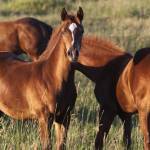Effects of Restricted Pasture Turnout on Forage Intake and Fecal pH

Owners of overweight horses have used a number of methods—grazing muzzles, drylotting, less time at pasture, no grain meals—in an attempt to help their chubby equines lose some weight. Reducing a horse’s grazing time would seem to be a good strategy, but some studies have shown that ponies were using their few pasture hours to put away almost as much forage as they had ingested while on 24-hour turnout. Another concern of limited intake is the possible negative effect on the horse’s digestive system when many hours are spent without any grass, hay, or grain passing through the stomach and intestines.
Eight mature geldings were used in a study conducted at North Carolina State University to determine if restricted pasture access affected horses’ intake rate, energy intake, and hindgut fermentation. The research team was led by Paul Siciliano, Ph.D., associate professor in the NCSU Department of Animal Science. The horses were divided into four pairs and each group was allowed pasture access for 3, 6, 9, or 24 hours for one week. Pasture foliage was made up of 54.7% crabgrass, 28.3% tall fescue, 8.2% foxtail, 1.14% dallisgrass, and 0.86% weeds, with 6.6% bare ground.
After seven days, the team reassigned the groups to a different turnout treatment on an ungrazed pasture until all horses had been subjected to each pasture treatment. The horses stayed in drylots pens with access to water and salt when they were not in the pasture, and horses in the three- and six-hour treatment groups had free-choice access to low-quality grass hay. During each period, the team recorded the amount of hay consumed. Fecal samples were collected from each horse on the last day of each period. The team also measured or estimated herbage mass (used to quantify pasture available to an animal), grazing height, and forage preference for each period. All pastures had the same digestible energy concentrations (DE) and initial herbage mass, though less pasture was available during periods 2 and 3 compared to 1 and 4.
Results showed that horses’ total daily dry matter (DM) intake (pasture plus hay, if hay was provided) was not affected by length of turnout time. In other words, horses consumed the same amount regardless of the amount of time they were allowed to graze. The highest total daily DM intake, which was 1.4% of body weight (BW), was in horses that were allowed to be on pasture for 24 hours. This total is less than the 2-3% BW suggested by some previous research. It is possible that the lower DM intake found in this study might have been related to high temperatures during some portions of the research. High temperatures have been shown to decrease forage intake up to 15-20% in horses, and forage growth may also have slowed due to heat. Pasture DM intake, total DM intake, and pasture DM intake rate were higher in periods 1 and 4 compared to 2 and 3, correlating to the amount of pasture available during those periods.
The rate of pasture DM intake rate increased with restricted grazing. In other words, horses made the most of their grazing time, eating more steadily and spending less time dozing, socializing, or moving around. Those grazing for only 3 hours had a higher intake rate compared to horses grazing for 9 and 24 hours, and horses grazing for 6 hours had a higher consumption rate than horses on pasture for 24 hours.
Fecal pH, an indicator of hindgut pH, decreased as time on pasture decreased, though all fecal pH values were within the range considered to be normal. This indicated that length of time on pasture affected hindgut microbial fermentation. The researchers thought the increase in rate of pasture intake could also have played a role in the lower fecal pH, especially when the horses consumed high-quality pasture. An unnaturally acidic environment in the hindgut (termed hindgut acidosis) can lead to colic and other health concerns.
Average DE intake was greatest when horses were on pasture for 24 hours, but total DE intake was similar for all treatments. During periods 1 and 4, average and total DE intake were greater than in periods 2 and 3. The horses consumed 40%, 66%, 67%, and 94% of their total DE requirements with 3, 6, 9, and 24 hours of pasture access, respectively.
In this study, reduced time on pasture increased consumption rate and decreased fecal pH in horses. This suggests that reducing pasture time for obese horses may not be effective in reducing caloric intake.








